
A PRACTICE AID FROM BDO’S PROFESSIONAL PRACTICE GROUP
Accounting for Leases Under ASC 842
UPDATED SEPTEMBER 2021
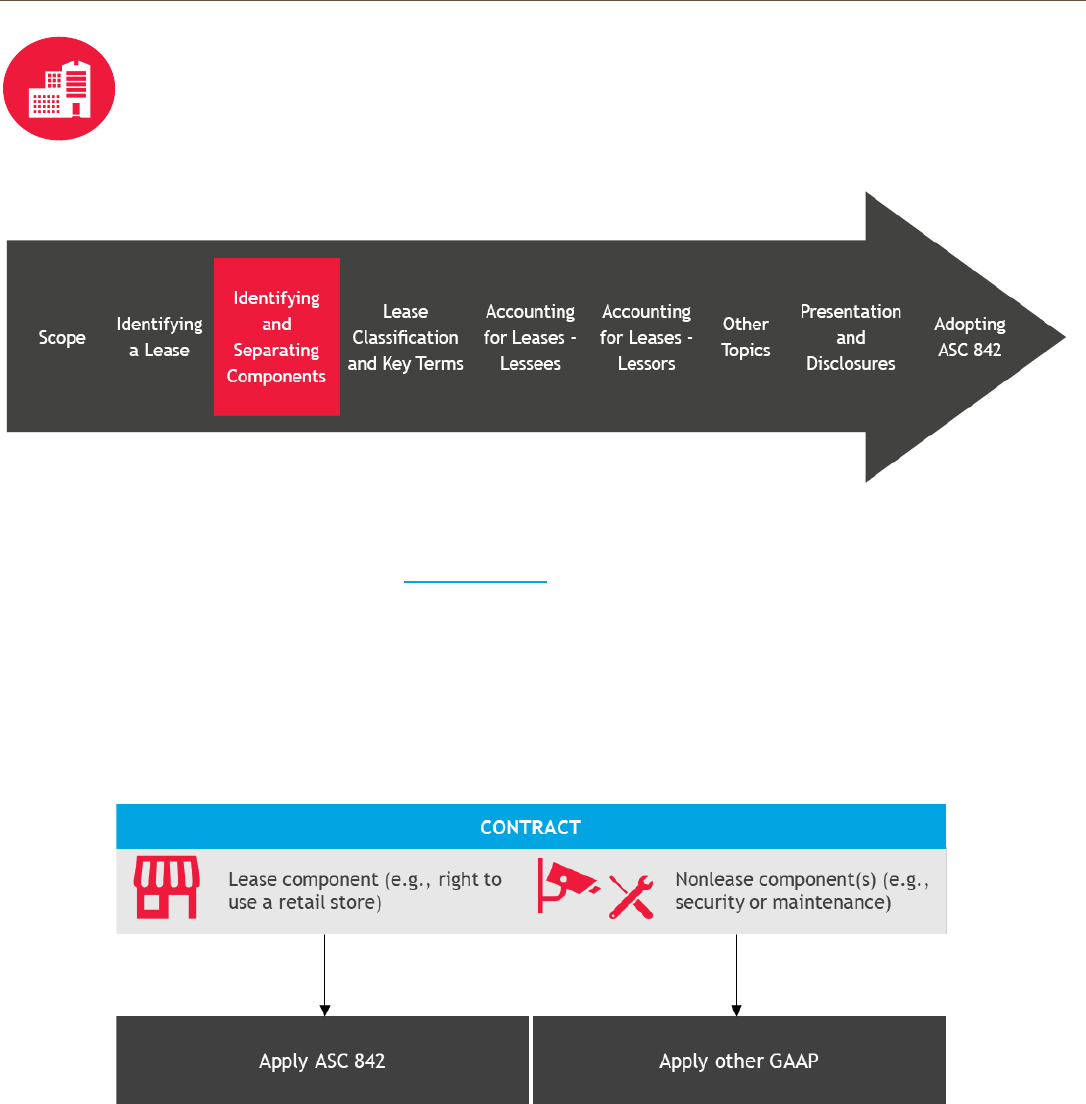
ACCOUNTING FOR LEASES UNDER ASC 842 2
BDO Knows Identifying and Separating
Components
OVERVIEW
In the previous article, we discussed how to identify a lease. Once an entity concludes that a contract is or contains a
lease, the next step is to identify the components of the contract. Those components are the units of account that
determine which GAAP applies, and they only include those items or activities that transfer a good or service to the
lessee. The definition of a lease is based on the right to use an identified asset and, therefore, the lease component
typically represents the right to use that identified asset (such as the right to use a retail store). A contract may also
include one or more nonlease components (such as maintenance or security services for that retail store). In that
scenario, the lease component is accounted for under ASC 842, while the nonlease component(s) are generally
accounted for under other GAAP.
A co
ntract may also include the lease of more than one asset. In those situations, the entity should evaluate how many
lease components there are. Generally, the right to use each individual asset represents a separate lease component.
For example, in a contract for the right to use two cars, each car represents a separate lease component, and the
contract therefore includes two lease components. But sometimes leases of multiple assets are accounted for as one
lease component depending on how dependent and interrelated, they are to each other. There are also specific
considerations for leases of land.
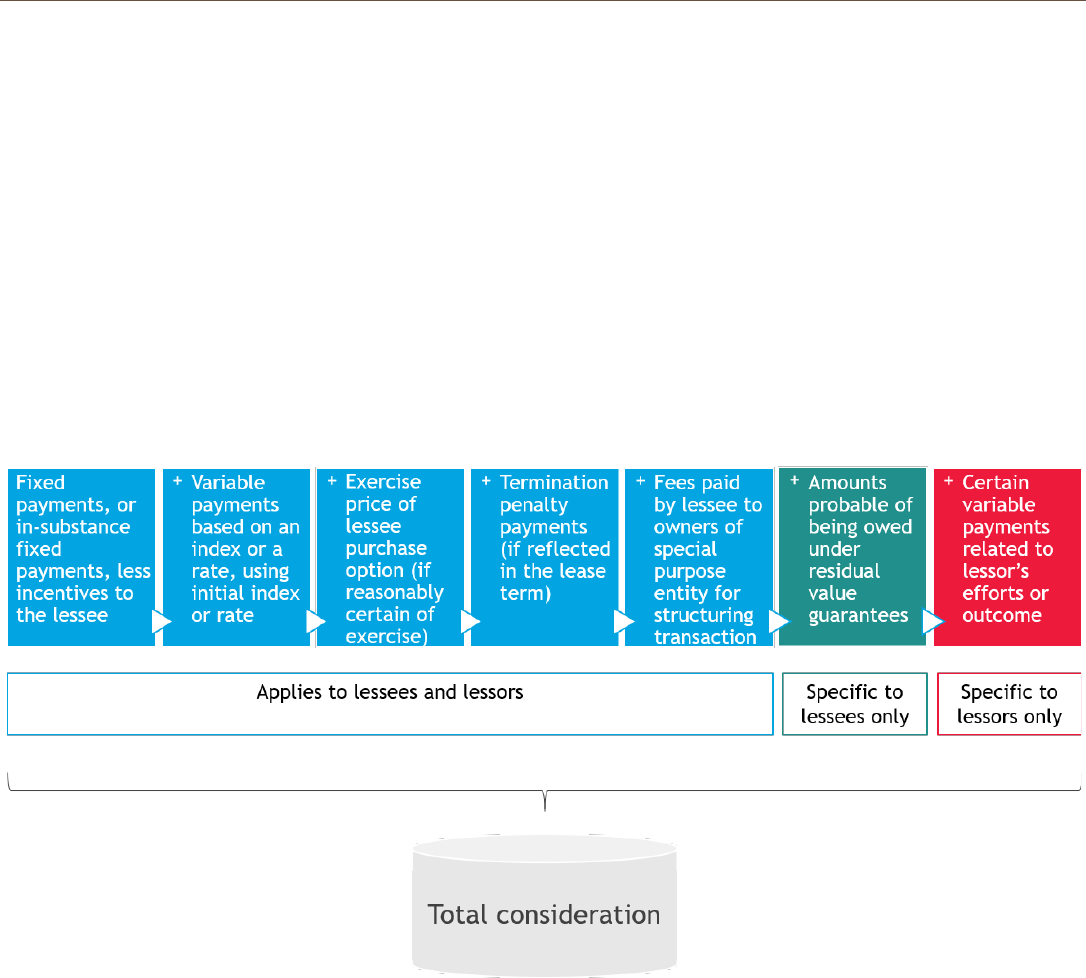
ACCOUNTING FOR LEASES UNDER ASC 842 3
Some items or activities do not transfer a good or service to the lessee and, therefore, are not considered components
of the contract. Those include:
Administrative tasks to set up the contract,
Cost that a lessor would incur in its role as a lessor or as owner of the underlying asset (e.g., property taxes
for which the lessor is the primary obligor and insurance that protects the lessor’s asset).
In addition to identifying the components of the contract, the entity must determine the consideration in the contract.
It typically includes fixed payments (including in-substance fixed payments) less incentives to the lessee, and variable
payments based on an index or a rate, measured using the index or rate at the commencement date. The consideration
may also include other payments depending on the contract’s terms, such as the exercise price of a lessee purchase
option if reasonably certain of exercise, or termination penalties if the lease term reflects exercise of a lessee
termination option. A lessee does not include variable payments other than those based on an index or a rate, while
lessors sometimes must include certain variable payments that relate specifically to nonlease components.
The following graph summarizes the consideration in the contract for lessees and lessors.
When a contract includes more than one lease component (for example, a contract with two lease components), or
includes a lease component and at least a nonlease component, the entity typically must separate and allocate the
consideration in the contract to those components, unless a practical expedient is elected (see below).
The allocation of the consideration is generally made on a relative standalone (selling) price basis, although lessors
must apply the allocation guidance in ASC 606.
Also, items or activities that do not transfer a good or service to the lessee do not receive an allocation of the
consideration in the contract because they are not considered components of the contract. This means that any
payments in the contract for these items or activities, whether fixed or variable, will generally be allocated to the
components of the contract as illustrated on the next page.
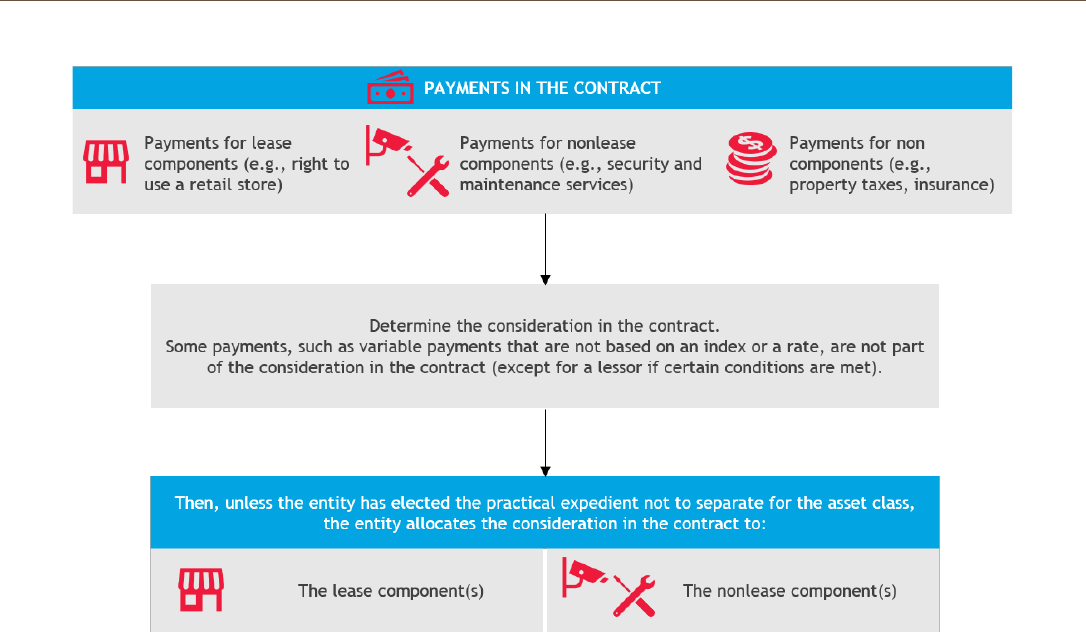
ACCOUNTING FOR LEASES UNDER ASC 842 4
However, lessees and lessors can elect a practical expedient by asset class not to separate the nonlease component(s)
from the associated lease component.
Lessees can generally apply the practical expedient without regard to conditions, and the combined component is
accounted for under ASC 842.
Lessors may account for each separate lease component and the nonlease components associated with that lease
component as a single lease component if the following three conditions are met:
The nonlease component(s) otherwise would be accounted for under ASC 606,
The timing and pattern of transfer of the lease component and nonlease component(s) associated with that
lease component are the same, and
The lease component, if accounted for separately, would be classified as an operating lease.
The accounting for the combined component then depends on which component of the contract is predominant which
will dictate whether the lessor applies ASC 842 or ASC 606.
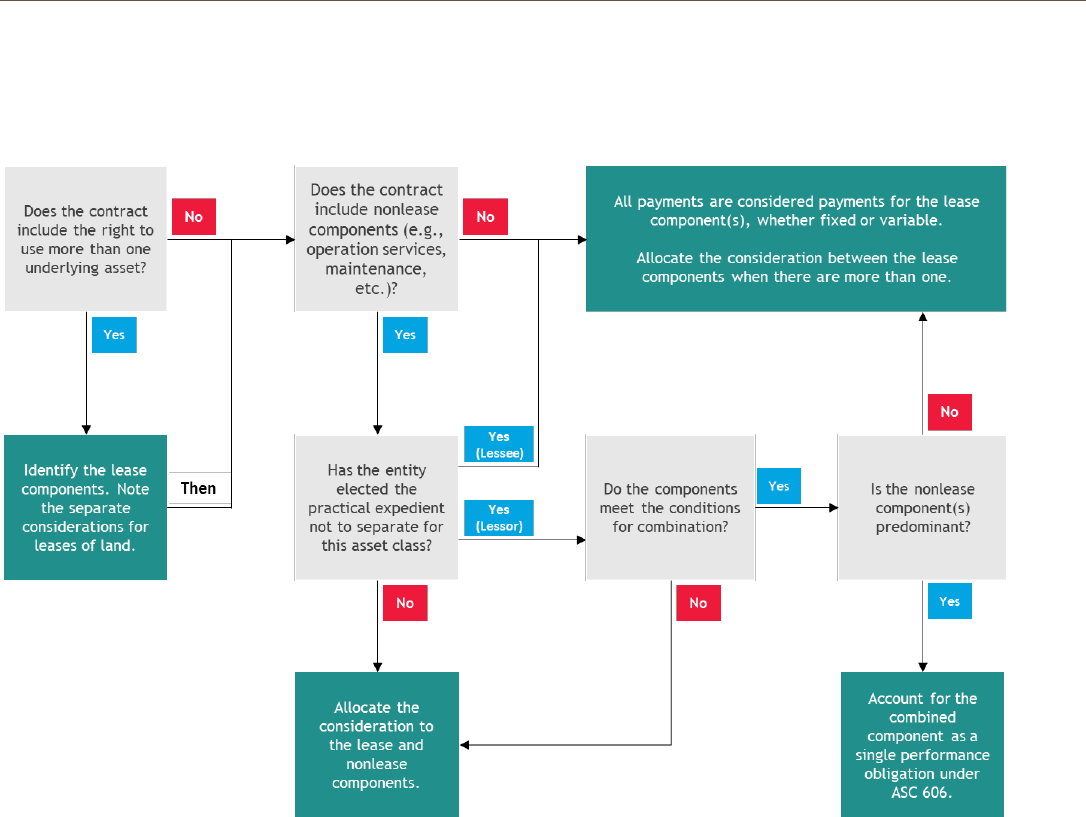
ACCOUNTING FOR LEASES UNDER ASC 842 5
The following flowchart summarizes the key steps an entity should perform, which we will discuss in further details in
this article.
Note that the above flowchart assumes that for a lessor, the nonlease component(s) in the contract will either meet
the conditions to be combined with the lease component or won’t. Sometimes, there may be nonlease components
that meet the conditions, while some others don’t. For example, a contract may include a lease of equipment,
maintenance services related to that equipment, and a sale of consumables. In that situation, the lease component
and maintenance services may meet the criteria to be combined, but the consumables will not because they are not
provided over time. Therefore, if the lessor elected the practical expedient for the asset class, the lessor should
allocate the consideration in the contract between the combined component (the lease component and maintenance)
and the other nonlease component, which is the consumables. We will discuss this in further details in Separating
Components – Lessors section below.
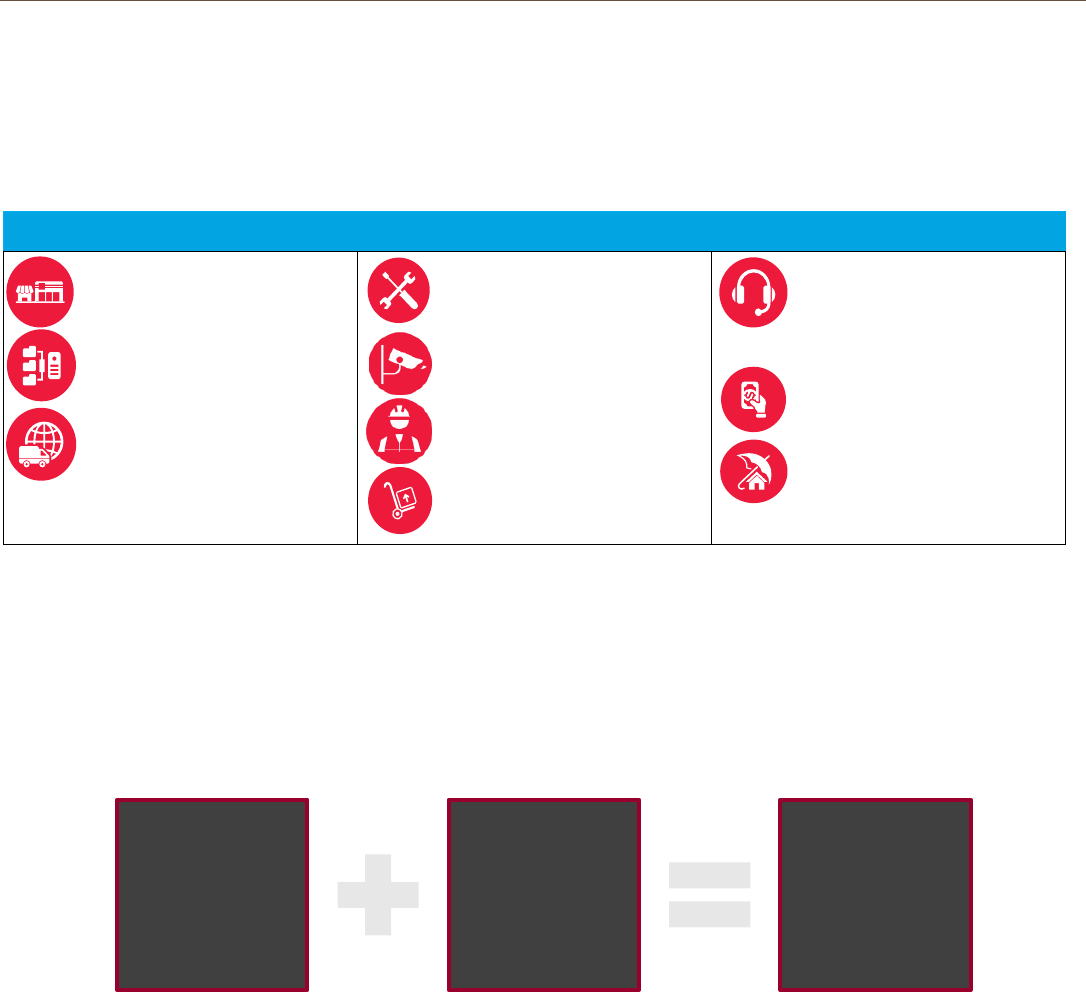
ACCOUNTING FOR LEASES UNDER ASC 842 6
IDENTIFYING LEASE AND NONLEASE COMPONENTS
IDENTIFYING COMPONENTS OF THE CONTRACT
Components of a contract include only those items or activities that transfer a good or service to the lessee. Some
other items or activities are not components.
Lease component examples Nonlease component examples Noncomponent examples
Right to use real estate,
such as a retail store.
Right to use computer
equipment.
Right to use a vehicle, such
as a truck.
Repairs and maintenance,
common area maintenance.
Other goods or services
provided to the lessee,
such as security services,
operating the asset (e.g., a
vessel, a drilling rig), sale
of consumables, etc.
Certain administrative tasks
to initiate the contract
(e.g., set up activities).
Reimbursement of lessor
costs related to ownership
of the leased asset (such as
property taxes and
insurance that protects the
lessor’s asset).
Lessees and lessors must identify the individual lease components and nonlease components of the contract, but do not
have to separate the nonlease components from the associated lease component if a practical expedient to not
separate is elected (see discussion below).
LEASE COMPONENT SEPARATION GUIDANCE
ASC 842 provides guidance in paragraph 842-10-15-28 on identifying separate lease components:
In assessing the first condition, readily available resources are goods or services that are sold or leased
separately (by the lessor or other suppliers) or resources that the lessee already has obtained (from the
lessor or from other transactions or events). An entity may consider the following questions in determining
whether this condition is met:
•
Is the asset readily sold or leased separately by the lessor or other suppliers?
•
Could the lessee readily lease or purchase an alternative asset to use with the other leased asset?
Lessee can benefit
from right of use
either on its own
or together with
other readily
available
resources
Right of use is
neither highly
dependent nor
highly interrelated
with other leased
assets
Separate lease
component

ACCOUNTING FOR LEASES UNDER ASC 842 7
In evaluating the second condition, a lessee’s right to use an underlying asset is highly dependent on or
highly interrelated with the right to use another underlying asset if each right of use significantly affects the
other. An entity may consider the following questions in determining whether this condition is met:
•
Can the lessor fulfill each of its obligations to lease one of the underlying assets independently of its
fulfilment of the other lease obligations?
•
Would there be significant costs and time for the lessor to be able to fulfill its obligation on each
leased asset?
•
Is the lessee’s ability to derive benefits from the lease of each asset significantly affected by its
decision to lease or not lease the other asset(s) from the lessor?
Lease Component Separation Guidance Similar to Guidance in ASC 606
The guidance in paragraph 842-10-15-28 on determining whether one or more lease components should be
accounted for separately is similar to the guidance in paragraphs 606-10-25-19 through 25-21 on determining
whether a good or service promised in a revenue contract is distinct, and therefore represents a separate
performance obligation. This linkage was intentional as ASC 842 incorporates concepts from ASC 606, and therefore
paragraph 842-10-15-28 should be applied in a manner similar to application of the guidance in ASC 606.
When applying paragraph 842-10-15-28, generally the right to use an underlying asset represents a separate lease
component. For example, in a contract for the right to use two cars, each car represents a separate lease component,
and the contract therefore includes two lease components. Also, while there are several potential underlying
components that comprise each car, including the engine, seats, etc., the integral parts of the car do not meet the
criteria for treatment as separate lease components. That is, the car is the lease component.
But in some cases, the right to use multiple underlying assets will represent a single lease component. Example 13 in
ASC 842-10-55 illustrates a contract for the lease of a gas-fired turbine plant that consists of the turbine housed within
a building together with the land on which the building sits. In that example, the rights to use the turbine, the
building, and the land are highly interrelated because each is an input to the customized combined item for which the
lessee contracted (i.e, the right to use a gas-fired turbine plant that can produce electricity for distribution to the
lessee’s customers). Accordingly, they represent a single lease component (absent additional considerations for land –
see below). However, the fact that a lessee will use multiple underlying assets for one purpose is not sufficient to
conclude that the rights of use are highly interrelated or interdependent of each other. The FASB illustrated this in
Example 11 of ASC 842-10-55. We also illustrate it in the following examples.

ACCOUNTING FOR LEASES UNDER ASC 842 8
Example 1 - Lease of Helicopter and Jet
FACTS
Lessee enters into a lease of a helicopter and a private jet from Lessor for two years for its key
executives in the company for a specific project requiring significant travel.
Lessor agrees to maintain the helicopter and the jet throughout the contract term.
ANALYSIS
Lessee can benefit from each of the two assets on its own or together with other readily available
resources. For example, Lessee could readily lease or purchase an alternative helicopter or jet to use
with the other asset.
Although Lessee is leasing the helicopter and jet for one purpose (key executives’ travel related to a
specific project), the helicopter and jet are not highly dependent nor highly interrelated with each other.
The two assets are not, in effect, inputs to a combined item for which Lessee is contracting. Lessor can
fulfill each of its obligations to lease one of the underlying assets independently of its fulfillment of the
other lease obligation, and Lessee’s ability to derive benefits from the lease of each asset is not
significantly affected by its decision to lease or not lease the other equipment from Lessor.
The maintenance services represent nonlease components because they provide Lessee with goods or
services separate from the lease of the jet and helicopter. Also, Lessor determines under ASC 606 that its
maintenance services for each piece of leased equipment are distinct and therefore are separate
performance obligations.
CONCLUSION
There are two separate lease components and two separate nonlease components, unless the entity elects the
practical expedient not to separate for this asset class, in which case:
For Lessee, the contract has two separate lease components under ASC 842 (see Separating Components –
Lessee section for additional details),
For Lessor, the contract has either two separate lease components under ASC 842 or two separate
performance obligations under ASC 606 depending on predominance (see Separating Components – Lessor
section for additional details).

ACCOUNTING FOR LEASES UNDER ASC 842 9
Example 2 - Lease of Air Purification System
FACTS
Clean Air Co. provides air purification systems, primarily to hospitals and other healthcare facilities,
under leasing arrangements.
Each system consists of multiple air filters and related equipment installed throughout the lessee’s
facility, in an amount and at locations determined based on the size and design of the facility.
Lessee enters into a contract with Clean Air Co. for an air purification system that can filter the air at
Lessee’s healthcare facility and for maintenance of the system.
Assume the contract contains a lease.
ANALYSIS
Because of airflow throughout Lessee’s facility, any individual air filter is ineffective on its own.
Achieving air purification requires the full complement of air filters and related equipment provided in
the arrangement.
Therefore, the use of each air filter and related equipment used for the air purification system is highly
dependent on the use of the other air filters and equipment. Each is an input to the customized combined
item for which Lessee has contracted (that is, the right to use an air purification system that can filter
the air at Lessee’s healthcare facility).
The maintenance services represent a nonlease component because they provide Lessee with goods or
services separate from the lease. Also, Clean Air Co. determines under ASC 606 that its maintenance
services represent a single performance obligation.
CONCLUSION
The contract contains one lease component (the right to use the air purification system) and one nonlease
component (maintenance of the system), unless the entity elects the practical expedient not to separate for this
asset class, in which case:
For Lessee, the contract has one lease component under ASC 842 (see Separating Components – Lessee
section for additional details).
For Lessor, the contract has either one lease component under ASC 842 or one performance obligation
under ASC 606 depending on predominance (see Separating Components – Lessor section for additional
details).

ACCOUNTING FOR LEASES UNDER ASC 842 10
Example 3 - Lease of Light Fixtures
FACTS
Lighting Co. provides energy-efficient light fixtures, primarily in industrial settings, under leasing
arrangements. Payments under the leasing arrangements are based on calculated cost savings to lessees.
Each arrangement consists of multiple light fixtures installed throughout the lessee’s facility, in an
amount and at locations determined based on the size and design of the facility.
Lessee enters into a contract with Lighting Co. for energy-efficient light fixtures.
Assume the contract meets the definition of a lease.
ANALYSIS
Lessee can benefit from each of the light fixtures on its own or together with other readily available
resources. For example, Lessee could readily lease or purchase alternative light fixtures.
The purpose of the light fixtures is to provide a lower cost alternative to traditional lighting solutions.
However, each light fixture provides a similar estimated cost saving and would provide the same level of
cost savings regardless of whether each light fixture was installed on its own, or as part of a larger
installation. Therefore, the right to use each light fixture is neither highly dependent on nor highly
interrelated with the use of the other light fixtures.
CONCLUSION
The contract contains multiple lease components; that is, each light fixture is a separate lease
component.
Lessee and Lighting Co cannot apply the practical expedient not to separate to this contract because
there are no nonlease components in the contract. However, the entity may consider applying a portfolio
approach (see Portfolio Approach section).

ACCOUNTING FOR LEASES UNDER ASC 842 11
SPECIFIC CONSIDERATIONS FOR LAND
Irrespective of the guidance discussed above on separating lease components, ASC 842 requires a lease of land to be
accounted for as a separate lease component unless the accounting effects of such separation would be insignificant.
Paragraph 842-10-15-29 discusses two examples in which the accounting effect is insignificant:
Separating the land component would not affect lease classification of any lease components,
The amount recognized for the land lease component would be insignificant.
The Board noted in paragraph BC147 of ASU 2016-02 that “land, by virtue of its indefinite economic life and
nondepreciable nature, is different from other assets, such that it should be assessed separately from other assets
regardless of whether the separating lease components criteria are met.”
Identifying Leases of Land
Determining whether a contract includes a lease of land will depend on the facts and circumstances. In some cases,
the analysis will be straightforward. For example, a contract for a lessee to lease an entire office building will
include a lease of land on which the building sits, regardless of whether such lease of land is explicitly stated in the
contract, because the lessee is leasing the entire building and therefore also exclusively benefits from the use of
the land. In other cases, further analysis may be required. For example, in a contract for a lessee to lease retail
space in a shopping mall, the analysis may depend on whether the lessee is the anchor tenant (and whether that
anchor tenant occupies substantially all the shopping mall space), or another tenant that leases a smaller space
(e.g., a lessee that leases a retail space on the second floor).
If it is determined that the contract includes a lease of land, the entity must account for the lease of land
separately from the lease of the other assets unless doing so would be immaterial (e.g., lease classification would
not change for either components, or the lease of land is immaterial).

ACCOUNTING FOR LEASES UNDER ASC 842 12
Example 4 - Lease of Land and Building
FACTS
Lessor and Lessee enter into a five-year lease of a single-story commercial office building.
Lessee has exclusive use of the building (i.e., it is a single-tenant office building).
The contract requires Lessee to pay Lessor for real estate taxes and insurance. Lessor is the primary
obligor for the real estate taxes (regardless of whether Lessor leases the building and who the lessee is).
Lessor is also the named insured on the insurance, which protects Lessor’s investment in the building.
The lease requires Lessor to perform landscaping services for Lessee.
ANALYSIS
Regardless of whether the contract explicitly provides for the lease of land, the contract includes a lease
of land because Lessee has exclusive use of the commercial office building, and therefore also exclusively
benefits from use of the land on which the building sits.
The lease of land and building are highly dependent on or highly interrelated with each other because
each right of use significantly affects the other. However, because the contract contains a lease of land,
Lessee and Lessor must consider the guidance in paragraph 842-10-15-29. Lessor and Lessee each
conclude that the effect of accounting for the land lease component separately would be insignificant. In
this contract, Lessee’s right to use the land and building is coterminous and separating the two
components would not change lease classification of either the land or building lease component.
The real estate taxes and insurance on the building are not considered components of the contract
because they are considered reimbursements of Lessor’s costs for the land and building. See Separating
Components – Lessee section and Separating Components – Lessor section for additional considerations on
taxes and insurance.
Finally, the landscaping services is a nonlease component because it transfers a good or service to Lessee
separate from the lease of land and building. Lessor also determines under ASC 606 that the landscaping
nonlease component represents a single performance obligation.
CONCLUSION
The contract includes two components: a single lease component (comprising the right to use the land
and building), and a nonlease component (landscaping services), unless the entity elects the practical
expedient not to separate for this asset class.
See Separating Components – Lessee section for additional guidance on accounting for the components
and Example 4A for a continuation of this Example for Lessee.
See Separating Components – Lessor section for additional guidance on accounting for the components
and Example 4B for a continuation of this Example for Lessor.

ACCOUNTING FOR LEASES UNDER ASC 842 13
Example 5 - Lease of Office Space
FACTS
Lessor and Lessee enter into a five-year lease for one floor in a 30-story office building in New York City.
Lessee has exclusive use of the floor.
The lease requires Lessor to perform common area maintenance (CAM) services.
The contract requires Lessee to reimburse Lessor for its pro-rata share of real estate taxes and insurance
incurred by Lessor on the building, and CAM charges. The CAM charges can be adjusted upward and
downward based on actual work performed by Lessor.
ANALYSIS
The contract does not include a lease of land because Lessee does not occupy substantially all of the
building (i.e., the land on which the building sits is shared by all of the tenants in the building).
The real estate taxes and insurance Lessee will pay to Lessor are not considered components of the
contract because they are considered reimbursements of Lessor’s costs for the building. See Separating
Components – Lessee section and Separating Components – Lessor section for additional considerations on
taxes and insurance.
The common area maintenance service is a nonlease component because it transfers a good or service to
Lessee separate from the lease of the floor. Lessor also determines under ASC 606 that the common area
maintenance represents a single performance obligation.
CONCLUSION
The contract includes two components: one lease component and one nonlease component (common area
maintenance services), unless the entity elects the practical expedient not to separate.
See Separating Components – Lessee section for additional guidance on accounting for the components
and Example 5A for a continuation of this Example for Lessee.
See Separating Components – Lessor section for additional guidance on accounting for the components
and Examples 5B and 5C for a continuation of this Example for Lessor.
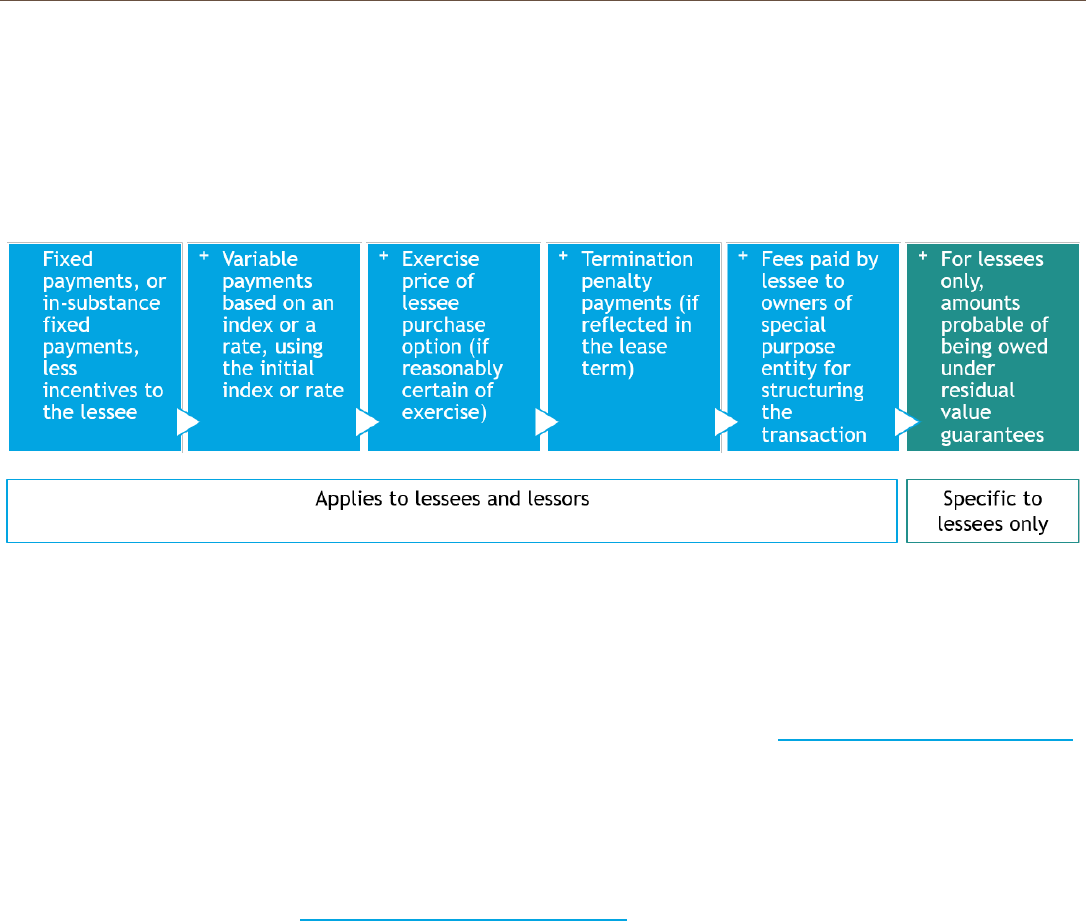
ACCOUNTING FOR LEASES UNDER ASC 842 14
SEPARATING COMPONENTS - LESSEES
DETERMINING THE CONSIDERATION IN THE CONTRACT
The consideration in the contract for a lessee is determined by applying paragraphs 842-10-15-35 and 842-10-30-5 and
includes the following payments that will be made during the lease term:
For a lessee, the sum of the above payments represents the total consideration in the contract, which the lessee
allocates to the separate lease and nonlease components of the contract, unless the lessee elects the practical
expedient to not separate for this asset class (see discussion below).
Variable payments that depend on an index or a rate are initially measured using the index or rate at the
commencement date. Subsequent changes to the index or rate during the lease term are accounted for as variable
payments, unless the lessee is required to remeasure the lease for other reasons (see Accounting for Leases – Lessees
for details).
Variable payments that do not depend on an index or a rate are not included in the determination of the total
consideration in the contract. This includes variable payments based on the performance of the asset, such as
payments based on a percentage of sales of the lessee, or reimbursement of actual costs incurred by the lessor (such as
property taxes and insurance).
The next article in this series on Lease Classification and Key Terms
discusses further details in-substance fixed
payments, lease incentives, purchase options and termination options.

ACCOUNTING FOR LEASES UNDER ASC 842 15
PROPERTY TAXES AND INSURANCE CONSIDERATIONS
A lessee’s requirement to pay costs that the lessor may incur in its role as a lessor or as owner of the underlying asset
do not transfer a good or service to the lessee separate from the lease. Example 12, Case A of ASC 842-10-55 provides
an example of a real estate lease and explains that:
The property taxes on the building would be owed by the lessor regardless of whether it leased the building
and who the lessee is; and
For the insurance, the lessor is the named insured on the building insurance policy and therefore the
insurance protects the lessor’s investment in the building.
Accordingly, the lessee paying those costs solely represents a reimbursement of the lessor’s costs. The fact that the
lessee pays a third-party, including the taxing authority, rather than reimbursing the lessor does not change this
conclusion. Also, the classification of a lease (e.g., as operating versus finance lease for the lessee) does not affect the
analysis of whether costs are considered lessor costs or lessee costs.
The accounting by a lessee for reimbursement of lessor costs depends on whether the payments are fixed or variable.
Payments are fixed Payments are variable
Payments are included in the consideration in the
contract, which is allocated to the lease and nonlease
components in the contract on a relative standalone
price basis, unless the lessee elects the practical
expedient not to separate for the asset class. Those
payment amounts (or a portion of those if there are
nonlease components) will affect the measurement of
the lease on balance sheet.
Payments do not represent variable payments based on
an index or a rate and, therefore, are not included in
the consideration in the contract. Once the variable
payments are incurred, they will be allocated between
the lease and nonlease components using the same
allocation as at contract’s inception, or most recent
reallocation.
Example: Lessee is required to pay lessor a fixed
amount per year for insurance coverage on the leased
asset.
Example: Lessee is required to reimburse lessor for
actual property taxes due on the asset under lease.
Property taxes do not represent an index or a rate, and
therefore are considered variable payments.
In some cases, there may be additional complexity in differentiating between lessee costs and lessor costs, particularly
for insurance contracts for which there may be elements benefitting the lessor (e.g., protecting the leased asset) and
others benefitting the lessee (e.g., protecting the lessee’s owned assets or other contingencies). In those situations,
additional analysis may be required to determine the portion of the payments that represent lessor costs (i.e., portion
of the premium that protects the lessor’s asset). Amounts that are considered lessee costs (i.e., portion of the
premium protecting the lessee’s assets) do not affect the accounting for the lease.

ACCOUNTING FOR LEASES UNDER ASC 842 16
SALES TAXES AND SIMILAR TAXES
When an entity enters into a lease, taxes may be assessed on the contract by a governmental authority. Those taxes
may be both imposed on and concurrent with a specific lease revenue-producing transaction and collected by the
lessor from a lessee. This includes for example sales, use, value added, and some excise taxes. Unlike lessors (see
Separating Components – Lessor section), lessees do not have a practical expedient to not assess such taxes.
Accordingly, a lessee is required to analyze sales taxes and other similar taxes on a jurisdiction-by-jurisdiction basis to
determine whether those taxes are the primary obligation of the lessor as owner of the underlying asset being leased
(i.e., the tax is a lessor cost) or whether those taxes are collected by the lessor on behalf of third parties (i.e., the tax
is a lessee cost).
If a lessor cost, the tax is accounted for either as part of the consideration in the contract (if the payments
are fixed) or as variable payments that do not depend on an index or a rate.
If a lessee cost, the tax typically does not impact lease accounting for the contract.
Like property taxes and insurance discussed above, the fact that the lessee pays a third-party directly rather than
reimbursing the lessor for the tax does not impact this conclusion.
PRACTICAL EXPEDIENT NOT TO SEPARATE
A lessee may elect as an accounting policy election by asset class, to not separate nonlease components from lease
components and instead, to account for each separate lease component and nonlease components associated with that
lease component as a single lease component.
The FASB provided this practical expedient to reduce cost and complexity in applying ASC 842. However, the election
of the practical expedient results in a larger right-of-use asset and lease liability on balance sheet, and it may also
change classification from an operating to a finance lease (See article 4 on Lease Classification and Key Terms
).
Accordingly, companies will need to consider the pros (e.g., simplicity) and cons (e.g., impact on accounting for the
lease, including balance sheet) of electing the practical expedient for their asset classes.
Nonlease Components “associated with” the Lease Component
ASC 842 does not define or provide guidance for determining whether a nonlease component is “associated with”
the lease component. A literal read of the requirements for the practical expedient may suggest that all nonlease
components, whether provided at a point in time or over time, that are associated with the lease component should
be combined with that lease component when the lessee elects the practical expedient. However, we note that ASC
842 illustrates in Example 11 of ASC 842-10-55 the application of the practical expedient to a contract in which the
nonlease component is maintenance services on construction vehicles. Paragraph BC 149 of ASU 2016-02 also notes
that “[t]he Board also decided that lessees should account for lease and nonlease (typically, service) components
separately (unless they elect the practical expedient) [Emphasis added].” Accordingly, we believe the practical
expedient to not separate was primarily intended for services and other nonlease components transferred over time
and that relate to the lease component (e.g., maintenance of a leased equipment, common area maintenance for a
lease of office space). For nonlease components provided at a point in time such as inventory purchases, we believe
a lessee will frequently conclude that the component is not associated with the lease component because the
lessee usually will be able to redirect the inventory and use it with a different asset, or to resell it in the market.
ALLOCATION OF CONSIDERATION TO LEASE AND NONLEASE COMPONENTS
If a lessee does not elect the practical expedient not to separate for an asset class, once the consideration in the
contract is determined and the components are identified, a lessee allocates the consideration to the lease and
nonlease components on a relative standalone price basis, based on the observable standalone price of each
component. A price is observable if it is the price at which either the lessor or similar suppliers sell similar lease or
nonlease components on a standalone basis.

ACCOUNTING FOR LEASES UNDER ASC 842 17
If observable standalone prices are not readily available, a lessee must estimate standalone prices maximizing the use
of observable information. A residual approach may be acceptable if the standalone price for a component is highly
variable or uncertain.
Paragraph BC156 in ASU 2016-02 states in part that “the allocation guidance for lessees is similar to that for lessors and
also is broadly consistent with that in previous GAAP.”
A lessee also allocates initial direct costs to the separate lease components on the same basis as the lease payments.
Example 6 – Lease of a Car
FACTS
Lessee leases a car for its salesperson from Dealership for three years.
Lessee has the right to drive the car for up to 15,000 miles per calendar year and to bring the car into the
maintenance department of Dealership once per quarter for regularly scheduled maintenance as defined
in the lease agreement.
The contract provides for a fixed payment of $415 per month.
Lessee is required to maintain full coverage insurance on the car to protect Dealership’s asset. Lessee
must contract directly with an insurance agency of its choice.
Lessee is required to pay for any maintenance services required beyond regularly scheduled maintenance
defined in the contract.
At the end of the lease term, Lessee is required to make additional fixed payments on a per mile basis for
any mileage greater than 45,000 miles.
Assume there are no lease incentives or initial direct costs.
WHAT ARE THE COMPONENTS?
The contract contains two components: a lease component (lease of the car) and a nonlease component
(maintenance services). The insurance coverage is not a component. It does not transfer a good or
service separate from the lease of the car (it represents a lessor cost of owning the asset).
However, Lessee may elect to apply the practical expedient not to separate for this asset class, in which
case the contract would contain a single lease component.
WHAT IS THE CONSIDERATION IN THE CONTRACT?
The contract includes a fixed monthly payment of $415, payments for insurance (paid by Lessee directly
to the insurance company of its choice), payments for excess mileage at the end of the lease term, and
payments for extra maintenance.
Only the fixed monthly payment of $415 is included in the consideration in the contract. The other
payments are variable payments that do not depend on an index or a rate.
The consideration in the contract is $14,940 ($415 x 36 months).

ACCOUNTING FOR LEASES UNDER ASC 842 18
WHAT ARE THE AMOUNTS ALLOCATED TO THE LEASE COMPONENT?
SCENARIO 1: Lessee elects practical expedient not to separate for this asset class.
In that situation, the contract includes only one component (i.e., the lease component).
The consideration in the contract of $14,940 is allocated entirely to the lease component and is used to
account for the lease (e.g., assess lease classification, recognize the lease on balance sheet, etc.).
All variable payments (for insurance, excess mileage and extra maintenance, if any) are considered
variable lease payments, which will be recognized in the period in which the obligation for those
payments is incurred. Lessee will also consider the guidance in paragraph 842-20-55-1 for variable
payments based on the attainment of 45,000 miles.
SCENARIO 2: Lessee does not elect practical expedient not to separate for this asset class.
In that case, Lessee allocates the consideration in the contract to the lease and maintenance components
on a relative standalone price basis. Lessee identifies observable standalone prices for the vehicle lease
and maintenance services. Lessee determines that it could enter into a maintenance agreement with an
unrelated service center for $30 per month, and Dealership commonly leases the same car on a
standalone basis for $400 per month. Therefore, the consideration in the contract is allocated to the
lease and non-lease components as follows:
Standalone Price
Relative
Standalone Price
Car lease
$14,400
$13,898 (93.02%)
Maintenance
1,080
1,042 (
6.98%)
$15,480
$14,940
The amount of the consideration allocated to the lease component ($13,898) is used to account for the
lease component (e.g., assess lease classification, recognize the lease on balance sheet, etc.).
The amount of consideration for the maintenance component ($1,042) is accounted for under other
GAAP.
All variable payments for insurance, excess mileage and extra maintenance will be allocated when
incurred using the same allocation basis as for the consideration in the contract (i.e., on a 93.02%/6.98%
basis).

ACCOUNTING FOR LEASES UNDER ASC 842 19
Example 4A - Lease of Land and Building (Continued) – Lessee Accounting
FACTS
Let’s continue with Example 4 in which Lessor and Lessee enter into a five-year lease of a single-story
commercial office building.
Lessee has exclusive use of the building (i.e., it is a single-tenant office building).
The lease requires Lessor to perform landscaping services for Lessee.
Lessee pays a fixed monthly payment of $12,000 per month in arrears which includes rent, landscaping
services, and reimbursement of Lessor’s costs.
Assume there are no lease incentives or initial direct costs.
WHAT ARE THE COMPONENTS?
As previously evaluated, the contract includes two components: a single lease component (comprising
the right to use the land and building), and a nonlease component (landscaping services).
However, Lessee may elect to apply the practical expedient not to separate for this asset class, in which
case the contract would contain a single lease component.
WHAT IS THE CONSIDERATION IN THE CONTRACT?
The consideration in the contract is $12,000 X 12 months X 5years = $720,000
WHAT ARE THE AMOUNTS ALLOCATED TO THE LEASE COMPONENT?
SCENARIO 1: Lessee elects practical expedient not to separate for this asset class.
In that situation, the contract includes a single lease component.
The consideration in the contract of $720,000 is allocated entirely to the lease component and is used to
account for the lease (e.g., assess lease classification, recognize the lease on balance sheet, etc.).
SCENARIO 2: Lessee does not elect practical expedient not to separate for this asset class.
In that case, Lessee allocates the consideration in the contract to the lease component and landscaping
services component on a relative standalone price basis. Lessee determines the standalone prices for the
lease component and nonlease component are $680,000 and $50,000, respectively. Therefore, the
consideration in the contract is allocated to the lease and non-lease components as follows:
Standalone Price
Relative
Standalone Price
Lease component
$680,000
$670,685 (93.15%)
Maintenance component
50,000
49,315 (
6.85%)
$730,000
$720,000
The amount of the consideration in the contract allocated to the lease component ($670,685) is used to
account for the lease component (e.g., assess lease classification, recognize the lease on balance sheet,
etc.). The amount of consideration for the maintenance component ($49,315) is accounted for under
other GAAP.

ACCOUNTING FOR LEASES UNDER ASC 842 20
Example 5A - Lease of Office Space (Continued) – Lessee Accounting
FACTS
Let’s continue Example 5 in which Lessor and Lessee enter into a five-year lease for one floor in a 30-
story office building in New York City.
The lease requires Lessor to perform common area maintenance (CAM) services.
The contract requires Lessee to pay rent of $50,000 per month in arrears and to reimburse Lessor for
Lessee’s pro-rata share of real estate taxes and insurance incurred by Lessor on the building, and CAM
charges.
The pro rata share of those reimbursements is initially estimated at $9,000 per month ($5,000 for taxes
and insurance and $4,000 for CAM). The CAM charges can be adjusted upward and downward based on
actual work performed by Lessor.
Assume there are no lease incentives or initial direct costs.
WHAT ARE THE COMPONENTS?
As previously evaluated, the contract includes two components: one lease component (lease of the floor)
and one nonlease component (CAM services).
However, Lessee may elect to apply the practical expedient not to separate for this asset class, in which
case the contract would contain a single lease component.
WHAT IS THE CONSIDERATION IN THE CONTRACT?
The consideration in the contract is $50,000 X 12 months X 5years = $3,000,000.
The other payments Lessee will make to Lessor for its prorata share of real estate taxes, insurance and
CAM are variable payments that do not depend on an index or a rate. Therefore, they are not included in
the consideration in the contract.
WHAT ARE THE AMOUNTS ALLOCATED TO THE LEASE COMPONENT?
SCENARIO 1: Lessee elects practical expedient not to separate for this asset class.
In that situation, the contract includes only one component (i.e., the lease component).
The consideration in the contract of $3,000,000 is allocated entirely to the lease component and is used
to account for the lease (e.g., assess lease classification, recognize the lease on balance sheet, etc.).
Lessee’s payments for its prorata share of property taxes, insurance and CAM are variable lease payments
that do not depend on an index or a rate and are excluded from the measurement of the lease liability.
Those variable lease payments are recognized in profit or loss when incurred.
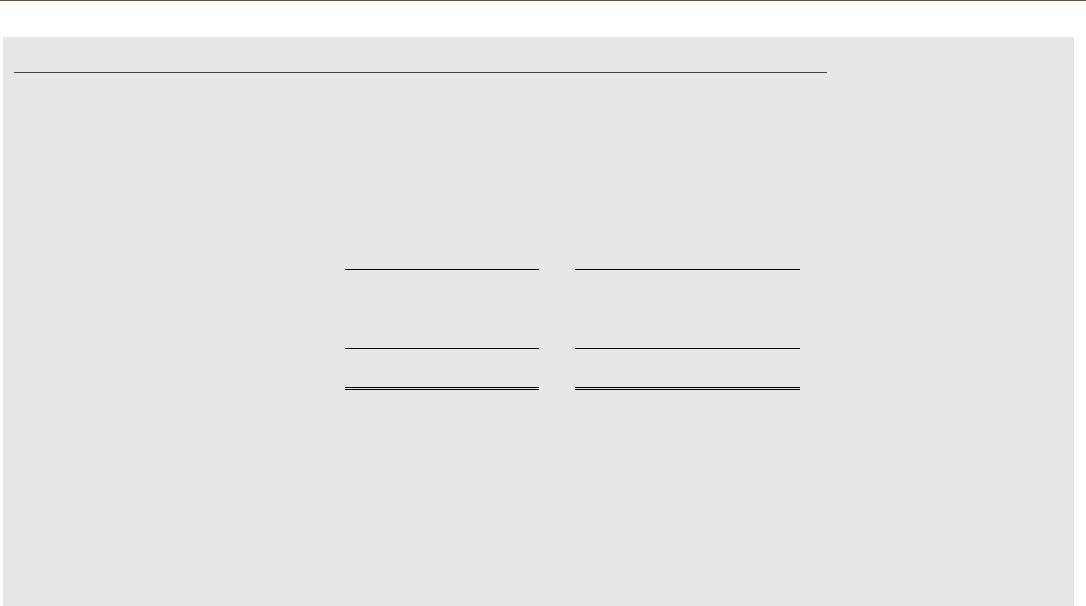
ACCOUNTING FOR LEASES UNDER ASC 842 21
SCENARIO 2: Lessee does not elect practical expedient not to separate for this asset class.
In that case, Lessee allocates the consideration in the contract to the lease and CAM components on a
relative standalone price basis. Lessee determines the standalone prices for the lease component and
CAM component are $3,270,000 and $270,000, respectively. Therefore, the consideration in the contract
is allocated to the lease and non-lease components as follows:
Standalone Price
Relative
Standalone Price
Lease component
$3,270,000
$2,771,186 (92.37%)
CAM component
(1)
270,000
228,814 ( 7.63%)
$3,540,000
$3,000,000
(1)
Includes an appropriate profit margin
The amount of the consideration allocated to the lease component ($2,771,186) is used to account for the
lease component (e.g., assess lease classification, recognize the lease on balance sheet, etc.).
The amount of consideration allocated to CAM services ($228,814) is accounted for under other GAAP.
All variable payments for Lessee’s prorata share of real estate taxes, insurance, and CAM are allocated
using the same allocation basis as for the consideration in the contract (i.e., on a 92.37%/7.63% basis).
In the prior example, it is important to note that if the practical expedient not to separate is not elected, the variable
payments must be allocated between the lease and nonlease components despite the fact that the lease clearly
provides for specific charges related to the nonlease services, i.e. CAM. This is because a lessee is not allowed to
allocate variable consideration solely to the nonlease component, as lessors are allowed to.
APPLYING THE RESIDUAL APPROACH
In accordance with paragraph 842-10-15-33, if a lessee has elected to separate lease and non-lease components, then
it must allocate the consideration in the contract between the lease component(s) and the non-lease component(s) on
a relative standalone price basis. The guidance further states that “if observable standalone prices are not readily
available, the lessee shall estimate the standalone prices, maximizing the use of observable information.” The
guidance also indicates that “a residual estimation approach may be appropriate if the standalone price for a
component is highly variable or uncertain.”
Paragraph BC156 of ASU 2016-02 states in part that “the allocation guidance for lessees is similar to that for lessors and
also is broadly consistent with that in previous GAAP.” Lessors apply the allocation requirements in ASC 606, including
paragraph 606-10-32-34, which provides the guidance on the suitable methods for estimating the standalone selling
prices (including a residual approach). In accordance with paragraph 606-10-32-34(c), under the residual approach an
“entity may estimate the standalone selling price by reference to the total transaction price less the sum of the
observable standalone selling prices of other goods or services promised in the contract. [Emphasis added]” However,
the following criteria must also be met in order to use the residual approach:
The entity sells the same good or service to different customers (at or near the same time) for a broad range
of amounts (that is, the selling price is highly variable because a representative standalone selling price is
not discernible from past transactions or other observable evidence); or
The entity has not yet established a price for that good or service and the good or service has not previously
been sold on a standalone basis (that is, the selling price is uncertain).
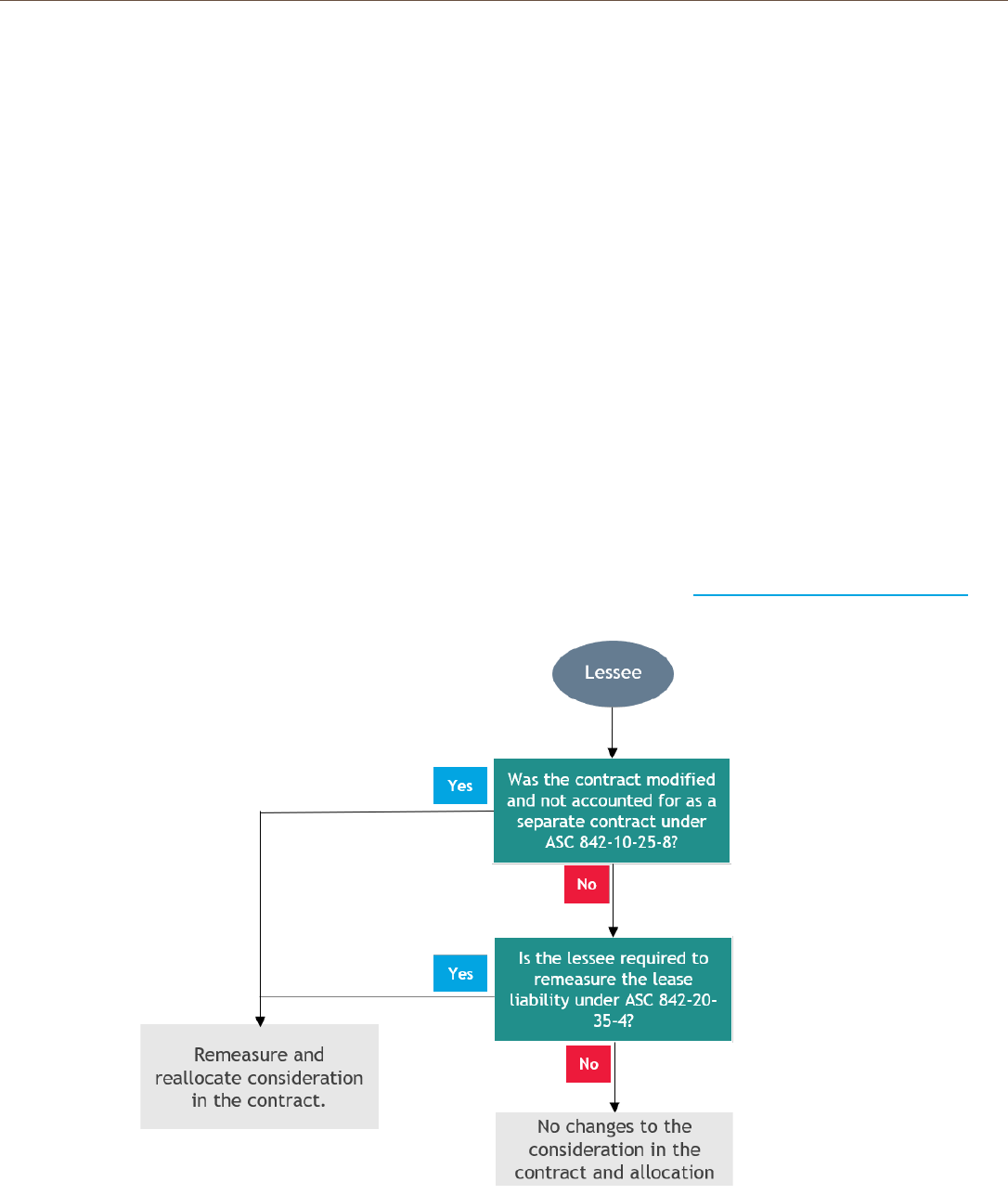
ACCOUNTING FOR LEASES UNDER ASC 842 22
As suggested by the guidance above, a lessee must have observable standalone prices for at least some of the
components in the contract to apply the residual approach. In other words, if the lessee does not have observable
standalone prices for any of the components, it must estimate the standalone price for all components. That is, the
lessee cannot use the residual approach.
In addition, in order for a lessee to meet the additional criteria and thus use the residual approach in a lease, the
entity i) would need to lease similar assets (for example, similar asset types and in a similar location) for a very broad
range of amounts indicating a representative standalone price is not discernible from past transactions or ii) has not
previously leased the applicable type of assets and is unable to determine a standalone price because there are no
similar transactions that the entity can use as a benchmark. It should be noted that the criteria in paragraph 606-10-
32-34(c) are deliberately very restrictive. Consequently, although a lessee could use the residual method if the criteria
are met, it is considered very unlikely that this will occur frequently in practice.
REMEASURING AND REALLOCATING THE CONSIDERATION
Inevitably, modifications to contracts and changes in facts and circumstances may occur during the contract term.
Paragraph 842-10-15-36 requires a lessee to remeasure the consideration in the contract and to reallocate the
consideration to the components in the contract when certain events occur. Those are:
The effective date of a contract modification that is not accounted for as a separate contract per paragraph
842-10-25-8, and
Remeasurements of the lease liability, such as a remeasurement resulting from a change in the lease term or
change in assessment of a lessee purchase option, per paragraph 842-20-35-4.
Events that require remeasurement will be discussed in further detail in article 5, Accounting for Leases - Lessees.
However, a lessee’s requirement to reallocate the consideration in the contract would depend on whether it elected
the practical expedient not to separate for the relevant asset class.
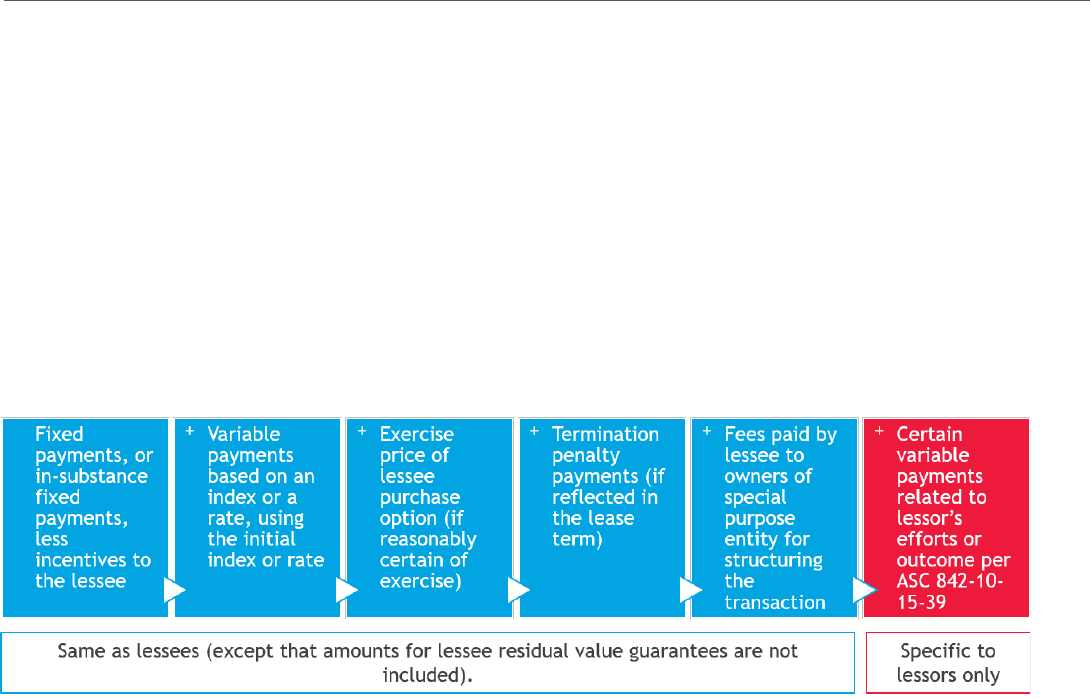
ACCOUNTING FOR LEASES UNDER ASC 842 23
SEPARATING COMPONENTS - LESSORS
DETERMINING THE CONSIDERATION IN THE CONTRACT
The consideration in the contract for a lessor includes as a starting point the payments described in paragraphs 842-10-
15-35 and 842-10-30-5 (that is, the same payment amounts as those determined by the lessee, except that a lessor
does not include amounts probable of being owed under a lessee residual value guarantee).
The consideration also includes certain variable payments related to the lessor’s efforts in transferring (or an outcome
in transferring) one or more goods or services that are not leases, consistent with the guidance in ASC 606.
There are also additional considerations for sales taxes and similar taxes, and reimbursements of lessor costs which we
will discuss separately.
The following graph summarizes a lessor’s consideration in the contract.
VARIABLE PAYMENTS RELATED TO LESSOR’S EFFORTS OR OUTCOME
The consideration for a lessor includes variable payment amounts that would be included in the transaction price in
accordance with the guidance on variable consideration in ASC 606 when they relate specifically to:
the lessor’s efforts to transfer one or more goods or services that are not leases, or
an outcome from transferring one or more goods or services that are not leases.
Those amounts are included in the consideration in the contract if it is probable that a significant revenue reversal in
the amount of cumulative revenue recognized will not occur when the uncertainty associated with the variable
consideration is subsequently resolved (consistent with the constraint on variable consideration in ASC 606).
However, if the terms of a variable payment amount (other than those that depend on an index or a rate) relate to a
lease component, even partially, the lessor does not include those payments in the consideration in the contract.
Example 14 in ASC 842-10-55 illustrates this guidance to a contract for the lease of equipment that includes
maintenance for which consideration is a fixed amount plus a variable payment amount based on a minimum number of
hours that the asset operates at a specified level of productivity. In Cases B and C of that example, the variable
payment amounts for maintenance are included in the consideration in the contract because the maintenance services
on the equipment are highly specialized and no entity would expect the equipment to meet the performance metrics
without the specialized maintenance services.
In real estate scenarios, examples of variable payments that would not be included in the consideration in the contract
include variable payments of the lessor’s property taxes and insurance, or payments based on sales of the lessee. This
is because those payment amounts relate at least partially to the lease component. Example of variable payments that
would be included in the consideration in the contract include payments for common area maintenance (CAM) services
if such payments relate solely to the lessor’s efforts to provide the CAM services.
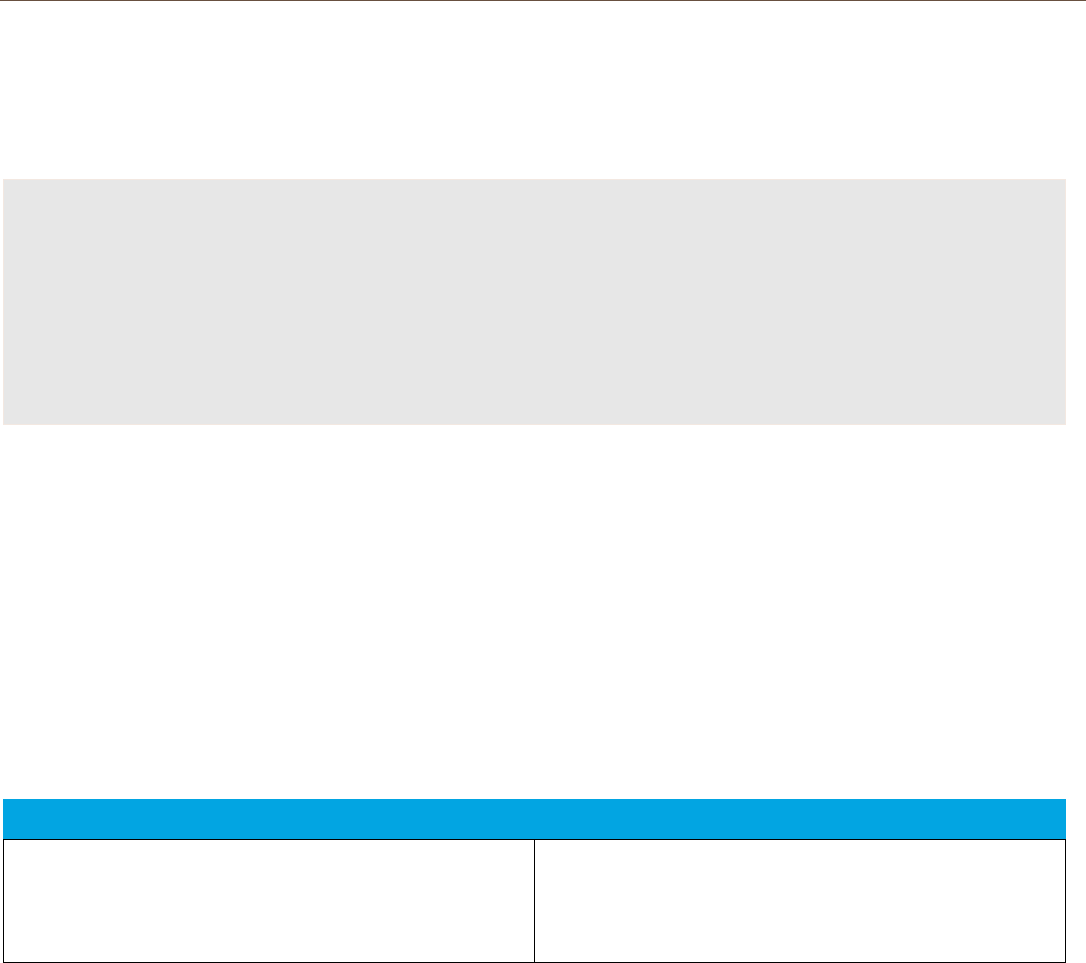
ACCOUNTING FOR LEASES UNDER ASC 842 24
However, even if variable payments relate specifically to the nonlease component(s), when a lessor elects the
practical expedient not to separate for the asset class (assuming the nonlease component qualifies for combination
with the lease component and the lease component is the predominant component), the variable payments are not
included in the consideration in the contract. This is because the lessor elected the practical expedient and the
variable payments now relate to the lease component. See further discussion below on the lessor practical expedient.
Assessment on Variable Payments by Lessor in accordance with ASC 606
The treatment of variable payments other than those based on an index or a rate is one major difference in the
determination of the consideration in the contract between lessees and lessors. Determining whether certain
variable payments relate solely to a nonlease component may require significant judgment, as may estimating the
consideration, subject to the constraint in accordance with ASC 606. Lessors that engage in transactions with
significant variable payments may consider developing a policy to assess in a consistent manner the nature of
variable payments including earning mechanisms and triggering points for payment to assess whether such
payments are solely related to a nonlease component in accordance with paragraph 842-10-15-39.
REIMBURSEMENT OF LESSOR COSTS
As previously explained, lessor costs such as property taxes on the underlying asset and insurance that protects the
lessor’s asset, are not considered a component of the contract. Absent guidance to the contrary, a lessor would be
required to report such lessor costs on a gross basis (i.e., as revenue and expenses) whether the lessee reimburses the
lessor or pays such costs on lessor’s behalf to a third-party. However, when the lessee pays a third-party directly,
lessors noted that reporting those costs in profit or loss would be costly and complex because the lessor may not have
visibility into the actual amounts paid by the lessee and therefore may need to estimate those amounts. Lessors also
questioned the usefulness of amounts reported because those often would be based on estimates that are affected by
lessee-specific factors (for example, insurance premiums paid by the lessee for a policy that protects both the lessor’s
asset and other assets that the lessee owns, amount of deductible selected by the lessee, etc.).
Accordingly, notwithstanding the guidance on variable payments discussed previously, the accounting for lessor costs is
as follows:
Lessee pays lessor costs directly to a third-party Lessor pays costs and is reimbursed by lessee
Exclude from variable payments.
In other words, treat like a lessee cost, which
does not affect the accounting for the lease.
Account for costs excluded from the consideration
in the contract as lessor costs (i.e., as variable
payments).
In other words, recognize on a gross basis.
SALES TAXES AND SIMILAR TAXES
A lessor can make an accounting policy election to exclude from the consideration in the contract and from variable
payments not included in the consideration all taxes assessed by a governmental authority that are both imposed on
and concurrent with a specific lease revenue-producing transaction and collected by the lessor from a lessee. This
includes for example sales, use, value added, and some excise taxes. Absent that practical expedient, the analysis of
sales taxes and similar taxes could be costly and complex depending on the number of jurisdictions and the variation
of, and changes in, tax laws among those jurisdictions.
This practical expedient is consistent with the practical expedient provided in ASC 606 and reduces costs and
complexity in assessing sales taxes and similar taxes. When the lessor makes the election, it should comply with the
disclosure requirements in paragraph 842-30-50-14.
However, taxes assessed on a lessor’s total gross receipts or on the lessor as owner of the underlying asset (e.g.,
property taxes – see discussion above) are excluded from the scope of this election.
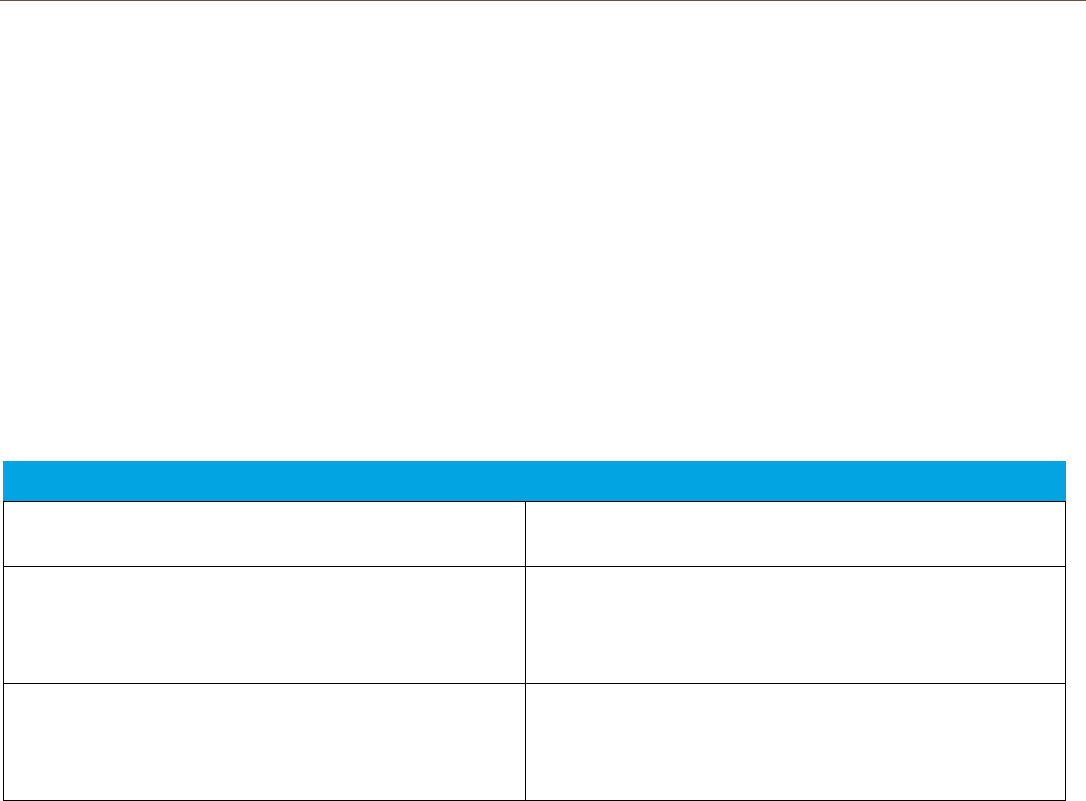
ACCOUNTING FOR LEASES UNDER ASC 842 25
PRACTICAL EXPEDIENT NOT TO SEPARATE
In July 2018, the FASB issued ASU 2018-11, which provides lessors with a practical expedient similar to lessees to not
separate lease and nonlease components by asset class, if certain criteria are met.
As provided by paragraph 842-10-15-42A, a lessor may, as an accounting policy election by asset class, choose to not
separate nonlease components from lease components and, instead, to account for each separate lease component and
the nonlease components associated with that lease component as a single lease component if the following three
conditions are met:
The nonlease component(s) otherwise would be accounted for under ASC 606,
The timing and pattern of transfer of the lease component and nonlease component(s) associated with that
lease component are the same, and
The lease component, if accounted for separately, would be classified as an operating lease.
Also, in accordance with paragraph 842-10-15-42B, for arrangements that qualify for the scope of this practical
expedient, the way in which a lessor accounts for the combined component depends on predominance:
Nonlease component(s) is (are) predominant Lease component is predominant
Account for combined component as a single
performance obligation under ASC 606.
Account for the combined component as a single
lease component under ASC 842.
Use same measure of progress used in
determining whether the arrangement qualified
for the expedient (i.e., the lessor uses a straight-
line measure of progress).
Account for the lease as an operating lease.
Account for all variable payments related to any
good or service,
including the lease
, that is part
of the combined component under the variable
consideration guidance in ASC 606.
Account for all variable payments related to any
good or service that is part of the combined
component as variable
lease
payments.
In assessing predominance, a lessor should evaluate whether the lessee would be reasonably expected to ascribe more
value to the nonlease component(s) than to the lease component.
Also, when a contract includes a lease component and multiple nonlease components, some of the nonlease
components may meet the conditions to be combined with the lease component, while other nonlease components
may not (for example, a nonlease component that transfers at a point in time). In this case, this does not preclude the
lessor from applying the practical expedient to the contract. However, the lessor is required to separate and allocate
the consideration in the contract between the combined component on one hand (i.e., the lease component and
nonlease components that meet the conditions) and the nonlease components (those that do not qualify) on the other
hand.

ACCOUNTING FOR LEASES UNDER ASC 842 26
Application Considerations for Lessor Practical Expedient Not to Separate
The following considerations are important in understanding and evaluating whether a lessor qualifies for the
practical expedient:
The practical expedient applies only to nonlease components that otherwise would be accounted for
under ASC 606. It does not apply, for example, to a contract that includes a lease component and a loan
component accounted for under ASC 310 on receivables.
Determining whether the lease component would be classified as an operating lease if accounted for
separately generally should not require a detailed quantitative analysis and may often be determined
using either a reasonable qualitative assessment, or a simplified quantitative approach in which all
payments in the contract are used to perform the present value classification test (to test if the lease
would be classified as an operating lease even with all payments) in addition to assessing the other lease
classification tests. However, in certain situations, additional analysis may be required.
Because the timing and pattern of transfer of the nonlease components must be the same as the timing
and pattern of transfer of the lease, the nonlease components will generally need to be recognized on a
straight-line basis (i.e., over time, time-based) to qualify for the practical expedient (see Note 1 below).
Performance obligations satisfied over time but using a measure of progress different from a time-
elapsed measure of progress, or performance obligations satisfied at a point in time (even if satisfied
ratably throughout the lease term), do not qualify for the practical expedient (See Note 2).
A lessor should be able to reasonably determine which component is predominant (i.e., a lessor does not
have to perform a detailed quantitative analysis or theoretical allocation). We also believe entities may
use a >50% threshold in determining which component is predominant for this lessor practical expedient
as discussed by the FASB in a public Board meeting.
We believe many lessor entities (including real estate entities and cable providers, to name a few) will take
advantage of this lessor practical expedient, as it generally may enable them to account for their transactions
under ASC 842 or ASC 606 in a manner similar to how they have accounted for them in the past, and how users of
their financial statements have used the information.
Note 1: Paragraph 842-30-25-11(a) requires a lessor to recognize operating lease payments on a straight-line basis
unless another systematic and rational basis is more representative of the pattern in which the lessee benefits
from use of the underlying asset. However, in practice, it generally is infrequent for anything other than straight-
line recognition to be applied.
Note 2: It is important to note that while the pattern of transfer of the nonlease components must be the same as
the lease component, the recognition of revenue does not have to be the same. For example, if the contract
includes variable consideration, the recognition pattern under ASC 606 for the nonlease component may not be the
same as the pattern of recognition under ASC 842. The fact that the two different standards provide for
differences in the recognition of variable consideration would not preclude a lessor from electing the practical
expedient if the timing and pattern of transfer of the lease and nonlease components are the same.

ACCOUNTING FOR LEASES UNDER ASC 842 27
Applying Lessor Practical Expedient May Change Amount of Consideration in the Contract
A key consequence of the lessor practical expedient not to separate is that it may change the consideration in the
contract for a lessor when the contract includes variable payments. For example, a real estate contract may
provide for the right to use an office building along with common area maintenance (CAM) services. The contract
may stipulate that the lessee will pay a fixed payment amount per month and will reimburse the lessor for property
taxes, insurance, and CAM costs incurred by the lessor. Absent the lessor applying the practical expedient for this
asset class, the lessee’s reimbursements for CAM services would meet the conditions in paragraph 842-10-15-39 to be
included in the consideration in the contract because the payments relate specifically to the lessor’s efforts in
transferring a good or service to the lessee that is not the lease. However, when the lessor has elected and applies
the practical expedient for this asset class, the contract includes only one lease component (assuming there are no
other nonlease components in the contract that do not qualify for the practical expedient). Accordingly, variable
payments the lessee will make to the lessor under the contract are all considered to relate to the lease component
(even the payments for CAM services), and therefore no variable payment amounts will be included in the
consideration in the contract. We illustrate this in Examples 5B and 5C below.
ALLOCATION OF CONSIDERATION TO LEASE AND NONLEASE COMPONENTS
If a lessor does not elect the practical expedient not to separate, or elects it but the criteria for combination are not
met for one or more nonlease components, the lessor allocates the consideration in the contract using the revenue
guidance in paragraphs 606-10-32-28 through 32-41.
Also, as previously discussed, lessors should include in the consideration in the contract (subject to the constraint)
variable payments that relate specifically to:
The lessor’s efforts to transfer one or more goods or services that are not leases, or
An outcome from transferring one or more goods or services that are not leases.
If included in the consideration, those variable payment amounts are allocated entirely to the nonlease component(s)
to which the variable payment specifically relates if doing so would be consistent with the transaction price allocation
objective in paragraph 606-10-32-28.
However, if the terms of the variable payment amount (other than those that depend on an index or a rate) relate to a
lease component, even partially, the lessor cannot recognize those payments before the changes in facts and
circumstances on which the variable payment is based occur (for example, when the lessee’s sales on which the
amount of the variable payment depends occur). When the changes in facts and circumstances on which the variable
payment is based occur, the lessor should allocate those payments to the lease and nonlease components of the
contract. In doing so, the allocation should be on the same basis as the initial allocation of the consideration in the
contract, or the most recent modification not accounted for as a separate contract, unless the variable payment meets
the criteria in paragraph 606-10-32-40 to be allocated only to the lease component(s). After this allocation then:
Variable payment amounts allocated to the lease component(s) are recognized as income in profit or loss in
accordance with ASC 842,
Variable payment amounts allocated to nonlease component(s) are recognized in accordance with other
Topics such as ASC 606.
A lessor also allocates any capitalized costs (for example, initial direct costs or contract costs capitalized under ASC
340-40 on other assets and deferred costs) to the separate lease components or nonlease components to which those
costs relate.

ACCOUNTING FOR LEASES UNDER ASC 842 28
Example 4B - Lease of Land and Building (Continued) – Lessor Accounting
FACTS
Let’s continue with Example 4 in which Lessor and Lessee enter into a five-year lease of a single-story
commercial office building.
Lessee has exclusive use of the building (i.e., it is a single-tenant office building).
The lease requires Lessor to perform landscaping services for Lessee.
Lessee pays a fixed monthly payment of $12,000 per months in arrears which includes rent, landscaping
services, and reimbursement of Lessor’s costs.
Assume there are no lease incentives or initial direct costs.
WHAT ARE THE COMPONENTS?
SCENARIO 1: Lessor elects practical expedient not to separate for this asset class.
Lessor determines that it meets the scope conditions of the practical expedient under paragraph 842-10-
15-42A because:
•
The landscaping services would otherwise be accounted for under ASC 606.
•
The lease component would be accounted for as an operating lease. Lessor performed this
assessment qualitatively considering the terms of the contract (Additional guidance on lease
classification will be covered in the next article in this series,
Lease Classification and Key
Terms
).
•
The lease component and nonlease component have the same timing and pattern of transfer (i.e.,
overtime, time-based). Lessor determined that the pattern of transfer of the landscaping services
would be time-based and over time under ASC 606 based on the nature of the performance
obligation.
Lessor also determines that the nonlease component is not the predominant component, because Lessee
would be reasonably expected to ascribe more value to the lease component than the nonlease
component.
Lessor notes that paragraph 842-10-15-42C is not applicable because there is only one nonlease
component and it qualifies for the practical expedient not to separate.
Accordingly, the contract includes one lease component (i.e., the combined components), which Lessor
accounts for as an operating lease under ASC 842 consistent with paragraph 842-10-15-42B.
SCENARIO 2: Lessor does not elect practical expedient not to separate for this asset class.
As previously evaluated in Example 4, the contract includes two components: a single lease component
(comprising the right to use the land and building), and a nonlease component (landscaping services).
Also, Lessor determines under ASC 606 that its landscaping services represent a single performance
obligation.
WHAT IS THE CONSIDERATION IN THE CONTRACT?
There are no variable payments in the contract. Therefore, the guidance in paragraph 842-10-15-39 does
not apply.
The consideration in the contract for Lessor is $12,000 X 12 months X 5years = $720,000.

ACCOUNTING FOR LEASES UNDER ASC 842 29
WHAT ARE THE AMOUNTS ALLOCATED TO THE LEASE COMPONENT?
SCENARIO 1: Lessor elects practical expedient not to separate for this asset class.
The consideration in the contract of $720,000 is allocated entirely to the lease component.
Lessor accounts for the lease component as an operating lease in accordance with paragraph 842-10-15-
42B, and therefore recognizes $720,000 on a straight-line basis over the lease term.
SCENARIO 2: Lessor does not elect practical expedient not to separate for this asset class.
In that case, Lessor allocates the consideration in the contract to the lease and nonlease components on a
relative standalone selling price basis. Lessor determines that the standalone selling prices for the lease
component and nonlease component are $680,000 and $50,000, respectively, using the guidance in ASC
606.
Therefore, the consideration in the contract is allocated to the lease and non-lease components as
follows:
Standalone
Selling Price
Relative Standalone
Selling Price
Lease component
$680,000
$670,685 (93.15%)
Maintenance component
50,000
49,315 ( 6.85%)
$730,000
$720,000
The amount of the consideration in the contract allocated to the lease component ($670,685) is used to
account for the lease component (e.g., assess lease classification, recognize lease revenue, etc.).
The amount of consideration for the landscaping component ($49,315) is accounted for under ASC 606.

ACCOUNTING FOR LEASES UNDER ASC 842 30
Example 5B - Lease of Office Space (Continued) – Lessor Accounting, Practical Expedient Not to Separate Is
Elected
FACTS
Let’s continue Example 5 in which Lessor and Lessee enter into a five-year lease for one floor in a 30-
story office building in New York City.
The lease requires Lessor to perform common area maintenance (CAM) services.
The contract requires Lessee to pay rent of $50,000 per month in arrears and to reimburse Lessor for
Lessee’s pro-rata share of real estate taxes and insurance incurred by Lessor on the building, and CAM
charges.
The pro rata share of those reimbursements is initially estimated at $9,000 per month ($5,000 for taxes
and insurance and $4,000 for CAM). The CAM charges can be adjusted upward and downward based on
actual work performed by Lessor.
Assume there are no lease incentives or initial direct costs.
Lessor elects the practical expedient not to separate for this asset class.
WHAT ARE THE COMPONENTS?
Lessor determines that it meets the scope conditions of the practical expedient in paragraph 842-10-42A
because:
•
The CAM services would otherwise be accounted for under ASC 606.
•
The lease component would be accounted for as an operating lease. Lessor performed this
assessment qualitatively considering the terms of the contract (Additional guidance on lease
classification will be covered in the next article in this series,
Lease Classification and Key
Terms
).
•
The lease component and nonlease component have the same timing and pattern of transfer (i.e.,
over time, time-based). Lessor determined that the pattern of transfer of CAM would be time-
based and over time under ASC 606 based on the nature of the performance obligation.
Lessor also determines that the nonlease component is not the predominant component, because Lessee
would be reasonably expected to ascribe more value to the lease component than the nonlease
component.
Lessor notes that paragraph 842-10-15-42C is not applicable because there is only one nonlease
component and it qualifies for the practical expedient not to separate.
Accordingly, the contract includes one lease component (i.e., the combined components).

ACCOUNTING FOR LEASES UNDER ASC 842 31
WHAT IS THE CONSIDERATION IN THE CONTRACT?
The consideration in the contract starts with the same amount as determined by Lessee, which is $50,000
X 12 months X 5years = $3,000,000
There are variable payments in the contract. Therefore, Lessor applies the guidance in paragraph 842-10-
15-39. However, Lessor determines that the payments Lessee will make to Lessor for its prorata share of
real estate taxes and insurance are variable payments that are not based on an index or a rate, and they
relate to the lease component.
Also, although the CAM payments relate specifically to the CAM services, Lessor elected the practical
expedient and therefore those payments are considered to relate to the lease component.
Accordingly, the expected amounts for property taxes, insurance and CAM are excluded from the
consideration in the contract in accordance with paragraph 842-10-15-40.
The consideration in the contract for Lessor is $3,000,000.
WHAT ARE THE AMOUNTS ALLOCATED TO THE LEASE COMPONENT?
The lease is accounted for as an operating lease consistent with paragraph 842-10-15-42B.
The consideration in the contract of $3,000,000 is allocated entirely to the lease component and is used
to recognize lease revenue on a straight-line basis over the lease term.
Because Lessee reimburses Lessor for property taxes and insurance (as opposed to paying directly a third-
party), Lessee’s payments for its prorata share of those activities are considered lessor costs in
accordance with paragraph 842-10-15-40A and are recognized on a gross basis in profit or loss.
Since Lessor elected the practical expedient not to separate, variable payments for property taxes,
insurance and CAM are considered variable lease payments and are recognized in accordance with
paragraph 842-30-25-11(b), which is when the changes in facts and circumstances on which the variable
payments are based occur.

ACCOUNTING FOR LEASES UNDER ASC 842 32
Example 5C - Lease of Office Space (Continued) – Lessor Accounting, Practical Expedient Not to Separate Is Not
Elected
FACTS
Let’s continue Example 5 in which Lessor and Lessee enter into a five-year lease for one floor in a 30-
story office building in New York City.
The lease requires Lessor to perform common area maintenance (CAM) services.
The contract requires Lessee to pay rent of $50,000 per month in arrear and to reimburse Lessor for
Lessee’s pro-rata share of real estate taxes and insurance incurred by Lessor on the building, and CAM
charges.
The pro rata share of those reimbursements is initially estimated at $9,000 per month ($5,000 for taxes
and insurance and $4,000 for CAM). The CAM charges can be adjusted upward and downward based on
actual work performed by Lessor.
Assume there are no lease incentives or initial direct costs.
Lessor does not elect the practical expedient not to separate for this asset class.
WHAT ARE THE COMPONENTS?
As previously evaluated in Example 5, the contract includes two components: one lease component (lease
of the floor) and one nonlease component (CAM services).
Also, Lessor determines under ASC 606 that its CAM services represent a single performance obligation.
WHAT IS THE CONSIDERATION IN THE CONTRACT?
The consideration in the contract starts with the same amount as determined by Lessee, which is $50,000
X 12 months X 5years = $3,000,000.
There are also variable payments in the contract. Therefore, Lessor applies the guidance in paragraph
842-10-15-39.
Lessor determines that Lessee’s payments for CAM services relate specifically to Lessor’s efforts to
transfer the CAM services.
Therefore, Lessor evaluates the variable payments in accordance with the variable consideration
guidance in paragraphs 606-10-32-5 through 32-13.
•
Lessor estimates that it will be entitled to receive $240,000 in variable payments for the CAM
services ($4,000 x 12 x 5years = $240,000).
•
Lessor also determines that it is probable that including that amount in the consideration would
not result in a significant reversal in cumulative revenue when the uncertainty of the payments is
resolved.
•
Accordingly, Lessor includes the amount it expects to be entitled to receive for the CAM services
of $240,000 in the consideration in the contract.
The other payments Lessee will make to Lessor for its prorata share of real estate taxes and insurance are
not based on an index or a rate. They also relate at least partially to the lease component. Accordingly,
the expected reimbursement amounts for property taxes and insurance are not included in the
consideration in the contract in accordance with paragraph 842-10-15-40.
The consideration in the contract for Lessor is $3,240,000 (3,000,000 + 240,000).

ACCOUNTING FOR LEASES UNDER ASC 842 33
WHAT ARE THE AMOUNTS ALLOCATED TO THE LEASE COMPONENT?
Lessor allocates the consideration in the contract to the lease and nonlease components using the
guidance in ASC 606. For example, if the CAM charges are not at their standalone selling price (for
example, CAM services are charged at cost without a profit margin), one acceptable allocation approach
may be for Lessor to allocate the entire amount of expected CAM reimbursements to the CAM component,
plus a portion of the fixed consideration to reflect an appropriate profit margin on the CAM services, if
that reasonably depicts the consideration Lessor expects to be entitled for each of the lease component
and CAM component.
The amount of the consideration in the contract allocated to the lease component is then used to account
for the lease component under ASC 842 (e.g., assess lease classification, recognize lease revenue on a
straight-line basis over the lease term if an operating lease, etc.).
The amount of consideration allocated to CAM services is accounted for in accordance with the guidance
on satisfaction of performance obligations in paragraphs 606-10-25-23 through 25-37. In this case, Lessor
determines that CAM services are provided over time, using a time-based measure of progress (i.e., on a
straight-line basis).
Lessor will consider the guidance on variable consideration in ASC 606 and update the amounts it expects
to be entitled for CAM services each reporting period. Lessor will allocate those changes consistent with
its initial allocation. For example, if Lessor initially allocated the estimated CAM payments entirely to the
CAM component, subsequent changes to that estimate may be allocated entirely to the CAM component.
Because Lessee reimburses Lessor for property taxes and insurance (as opposed to paying directly a third-
party), Lessee’s payments for its prorata share of those activities are considered lessor costs in
accordance with paragraph 842-10-15-40A and are recognized on a gross basis in profit or loss.
Also, Lessor will allocate the variable payments for property taxes and insurance to the lease and
nonlease components in accordance with paragraph 842-10-15-40; that is, on the same basis as the initial
allocation of the consideration in the contract (or most recent modification not accounted for as a
separate contract, if any), unless the variable payment meets the criteria in paragraph 606-10-32-40 to
be allocated only to the lease component. For example, Lessor may allocate the entire payments for
property taxes and insurance to the lease component if that is consistent with the initial allocation
performed and the allocation objective.
Then,
•
Variable payment amounts allocated to the lease component are recognized as income in profit or
loss in accordance with paragraph 842-30-25-11(b) which is when the changes in facts and
circumstances on which the variable payments are based occur.
•
Variable payment amounts allocated to the nonlease component, if any, are recognized in
accordance with ASC 606.

ACCOUNTING FOR LEASES UNDER ASC 842 34
REMEASURING AND REALLOCATING THE CONSIDERATION
A lessor remeasures and reallocates the remaining consideration in the contract when there is a contract modification
that is not accounted for as a separate contract under paragraph 842-10-25-8. This also includes situations described in
paragraph 842-10-35-3 (for example, when the lessee exercises a renewal or purchase option that the lessor previously
determined was not reasonably certain of exercise).
Also, a lessor allocates subsequent changes in variable consideration in accordance with the requirements in
paragraphs 606-10-32-42 through 32-45. For example, in Example 5C above the lessor included estimated CAM
payments in the consideration in the contract. If the estimate subsequently changes, the additional consideration
should be allocated to the lease and nonlease components on the same basis that the initial consideration was
allocated.
PORTFOLIO APPROACH
Paragraph 120 in the Basis for Conclusions in ASU 2016-02 indicates that ASC 842 permits an entity (lessee or lessor) to
apply the leases guidance at a portfolio level for leases with similar characteristics as long as the use of the portfolio
approach would not differ materially from the application of ASC 842 to the individual leases in the portfolio.
Paragraphs 842-20-55-18 through 55-20 also provide an example in which the portfolio approach is utilized in
determining the discount rate for the lease.
The portfolio approach may also be used to account for multiple lease components that have the same characteristics
including commencement date, lease term, and lease classification, such as a lease of three vehicles, or a lease of
multiple floors in a multi-floor building. However, the application of the portfolio approach could result in additional
complexity when the entity applies the subsequent measurement guidance of ASC 842 (for example, for a lessee, on
impairment and abandonment considerations, or contract modification considerations – see upcoming article on
Accounting for Leases - Lessees
for further details).
CONTRACT COMBINATION
Two or more contracts must be combined, at least one of which is or contains a lease, when they are entered into at or
near the same time with the same counterparty (or related parties) and consider those contracts as a single transaction
if either:
They were negotiated as a package with the same commercial purpose,
The amount of consideration to be paid in one contract depends on the price or performance of the other
one, or
The rights to use the underlying assets conveyed in the contracts are a single lease component based on the
separation guidance described above.
Combination Guidance Aligned with Revenue Guidance
The guidance in paragraph 842-10-25-19 on contract combination is consistent with the guidance in paragraph 606-
10-25-9 on combining revenue contracts. This linkage was intentional, as the new lease standard incorporates
concepts from the new revenue recognition guidance.

ACCOUNTING FOR LEASES UNDER ASC 842 35
Contacts
Oran Asher Professional Practice Manager oasher@bdo.com
Lisa Edelman
Professional Practice Senior Manager
ledelman@bdo.com
Thomas Faineteau
Professional Practice Partner
Jin Koo Professional Practice Partner [email protected]
Angela Newell
Professional Practice Partner
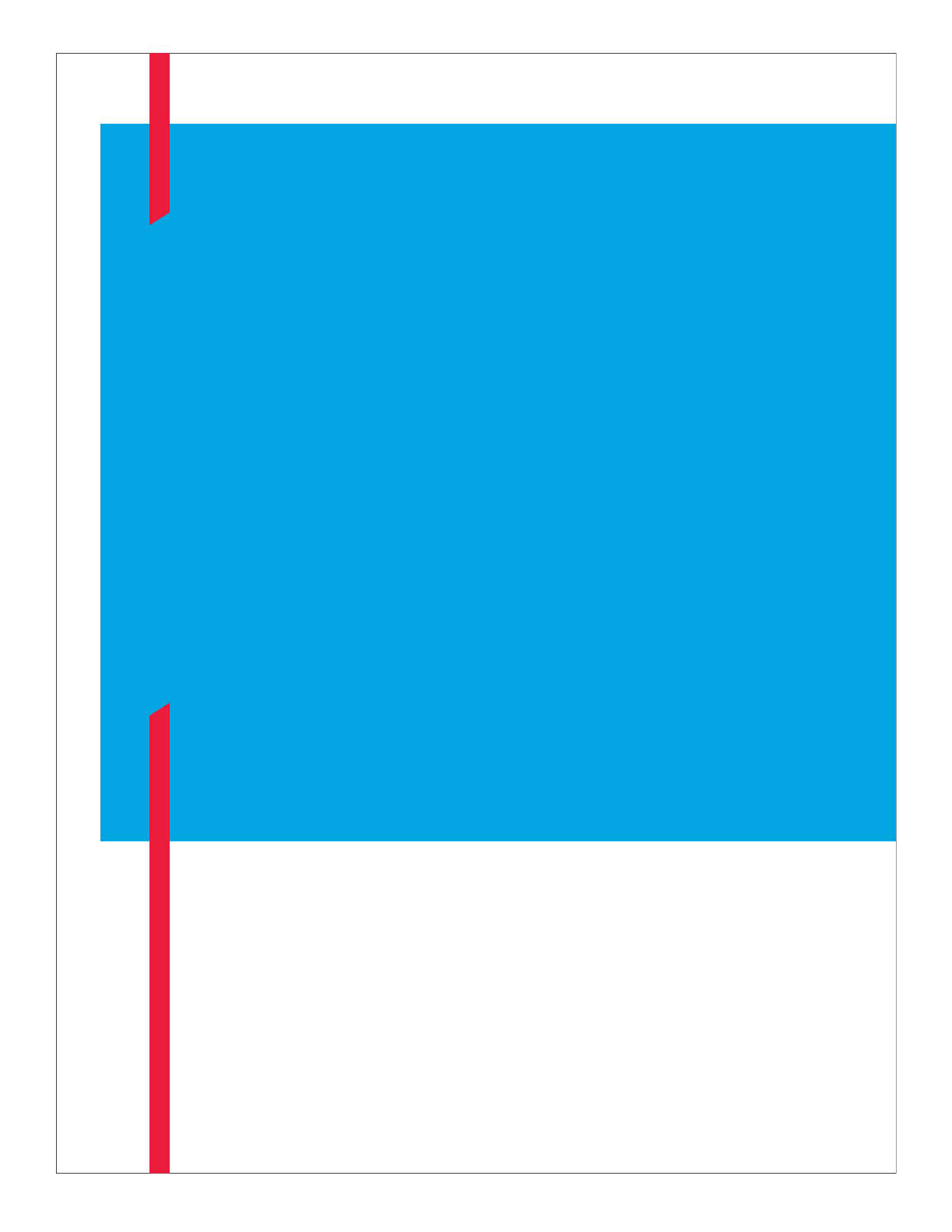
ACCOUNTING FOR LEASES UNDER ASC 842 36
BDO is the brand name for BDO USA, LLP, a U.S. professional services firm
providing assurance, tax, and advisory services to a wide range of publicly
traded and privately held companies. For more than 100 years, BDO has
provided quality service through the active involvement of experienced and
committed professionals. The firm serves clients through more than 70
offices and over 750 independent alliance firm locations nationwide. As an
independent Member Firm of BDO International Limited, BDO serves multi-
national clients through a global network of more than 91,000 people
working out of more than 1,650 offices across 167 countries and territories.
BDO USA, LLP, a Delaware limited liability partnership, is the U.S. member
of BDO International Limited, a UK company limited by guarantee, and forms
part of the international BDO network of independent member firms. BDO is
the brand name for the BDO network and for each of the BDO Member Firms.
www.bdo.com
Material discussed in this publication is meant to provide general
information and should not be acted on without professional advice tailored
to your needs.
© 2021 BDO USA, LLP. All rights reserved.
